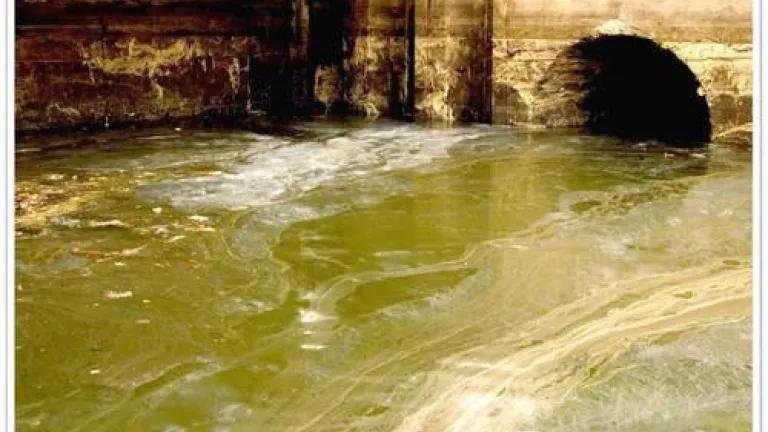Obama 2013 Budget on Water Infrastructure: Wrong on Spending Cuts; Right on Green Infrastructure

- Sewer Overflow: Newtown Creek, Brooklyn (Courtesy of Riverkeeper)
You may not notice until there’s a water main break, a flooded street, or a sewage overflow, but there’s likely a vast network of pipes carrying wastewater, stormwater and clean drinking water all around you. That’s especially true if you live in a city. Unlike power lines, roads, railways, or airports, this infrastructure is largely hidden from our view. Yet, it has helped enable the growth of modern cities and economies by providing water for drinking, cooking, bathing, manufacturing, and numerous other uses and by transporting and treating sewage to prevent the spread of disease. This infrastructure provides drinking water to 84 percent of the total population in the U.S.—that’s over 260 million people—and treats sewage from 75 percent of the population (over 230 million people).
Despite the importance of water in our lives (just think about how long it’s been since you last turned on a faucet or flushed a toilet), our nation’s water infrastructure is in desperate need of repair. According to an infrastructure needs survey by EPA, nearly $335 billion worth of repairs, upgrades, and replacements are needed by water systems in the next 20 years to continue providing safe drinking water and protecting public health. Almost $300 billion is needed to repair and replace wastewater and stormwater pipes and treatment plants. Furthermore, the National Association of Clean Water Agencies (NACWA) and the Association of Metropolitan Water Agencies (AMWA) estimate that utilities will need to spend $448 billion to $944 billion by 2050 to deal with climate change impacts.
Considering the significant water infrastructure needs our country is facing, the Clean Water and Safe Drinking Water State Revolving Funds (SRFs) have never been more important. These funds help finance projects that handle and treat domestic sewage and stormwater and that deliver drinking water to homes and businesses. These infrastructure investments also create jobs and have a positive impact on the economy well beyond the amount spent.
Unfortunately, President Obama’s FY13 budget proposes a $359 million reduction to the SRFs from the $2.39 billion appropriated in FY12. The nation’s water infrastructure needs already far exceed the funding available—cutting the revolving funds means that a greater number of deserving community projects will not be able to get done. This approach will only imperil our infrastructure and the healthy communities it helps foster.
Oddly, this backtracking comes in the same budget that the administration is touting as an investment in needed infrastructure. And, in an only-in-Washington moment mere hours after the announcement of this cut, EPA posted a link on one of its Facebook pages today to an American Society of Civil Engineers graphic noting the economic consequences of not investing in water infrastructure.
On a brighter note, the FY13 budget proposes that at least 10 percent of funds made available to states under the Drinking Water SRF and at least 20 percent of funds under the Clean Water SRF go towards projects such as green infrastructure, water efficiency, and other environmentally innovative projects. Green infrastructure – techniques like green roofs, rain gardens, and permeable pavement – help to capture stormwater runoff, reduce pollution, and increase local water supplies—and cities across the U.S. are increasingly looking to these practices to reduce runoff pollution, save money, and beautify neighborhoods.
Congress should commit to providing the necessary funding to maintain and upgrade our nation’s ailing water infrastructure and make sure that green infrastructure is a critical part of this process.